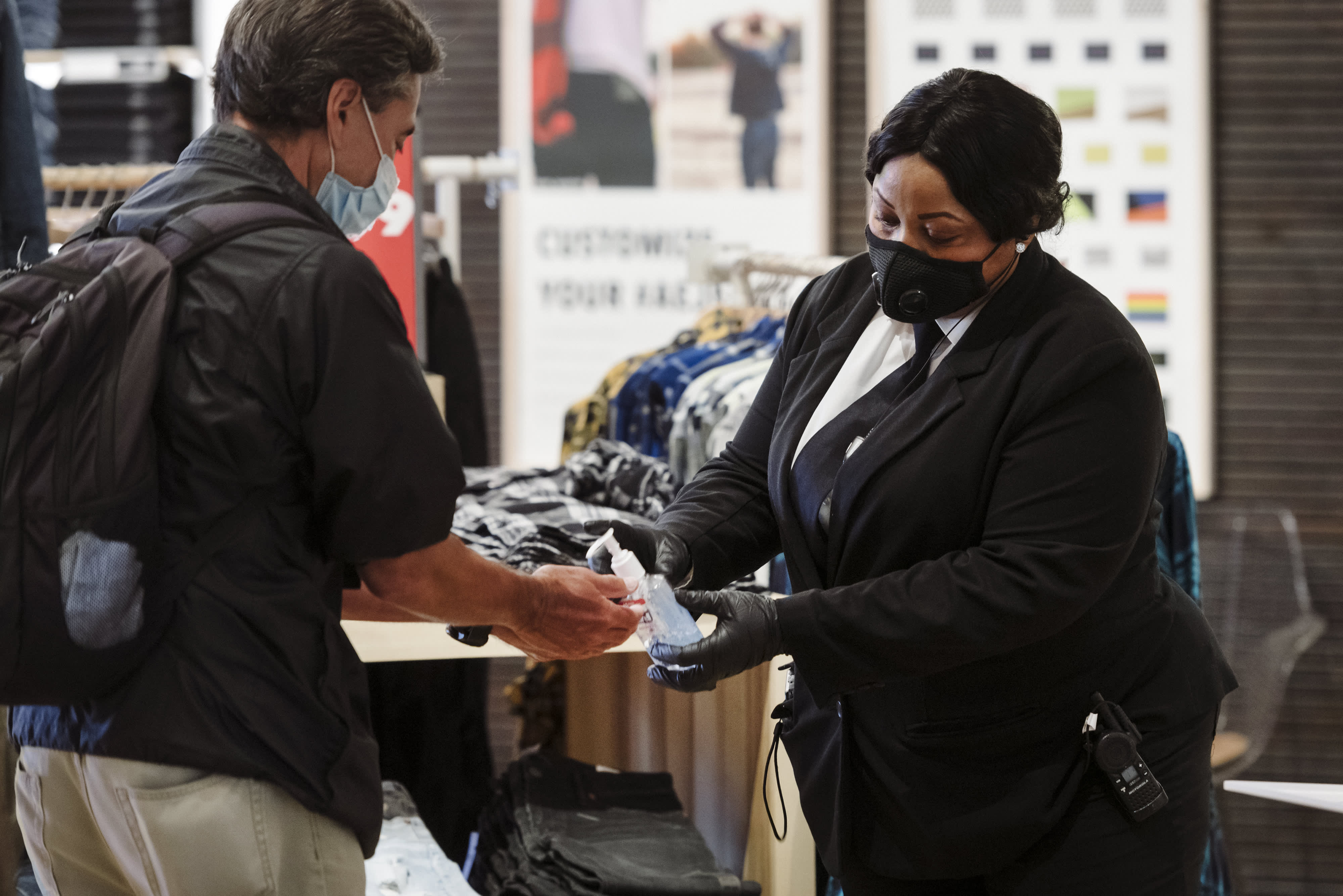A security guard wearing a protective mask gives a shopper hand sanitizer at a store in San Francisco, California, during a phase of reopening in June.
Michael Short | Bloomberg | Getty Images
After 102 days with no community spread of Covid-19, New Zealand on Tuesday announced four new cases that were transmitted locally, causing some areas of the country to reinstate lockdown restrictions that had not been in place since early June. Though it was short-lived, New Zealanders enjoyed a few months of normalcy — walking around without masks, commuting into the office for work, packing into bars and restaurants to meet up with friends — that has been enviably out of reach for most Americans.
Now entering the fifth month of economic disruption caused by the coronavirus, the U.S. economy as a whole — and the small business economy in particular — has made only modest progress in reopening. In the latest CNBC|SurveyMonkey Small Business Survey, the Small Business Confidence Index rose to a score of 53 out of a possible 100, still nine points off its Q1 score and its second-lowest score after hitting a record low last quarter.
Many have hoped for a “V-shaped” recovery, in which economic indicators bounce back just as quickly as they fell after the pandemic caused widespread layoffs and business closures in the spring. Instead, businesses in the U.S. are reopening haltingly, as consumers and workers take stutter steps back to normal.
In the CNBC|SurveyMonkey survey of 2,040 small business owners in the U.S., 58% of those who are currently operating say their business has remained open throughout the pandemic. That leaves about four in 10 small businesses that have closed and either reopened fully (8%), reopened at limited capacity (19%), or that are still waiting to reopen (11%).
Small business owners are having to reimagine what work will look like from several different angles: What are their customers demanding? What is best for their employees? And, at the most basic level, what is necessary in order to stay afloat?
Hesitancy among consumers
Safety is top of mind as consumers begin to leave their home to do activities that were once quotidian: riding the bus, shopping at the mall, exercising at the gym.
In SurveyMonkey’s weekly coronavirus tracking, more than 6 in 10 people in the U.S. continue to say they are more concerned that businesses are reopening too quickly than too slowly. That number has held steady since early June.
Some industries have it worse than others. Anything involving enclosed spaces where people are likely to bump up against others and breathe in poorly-circulated air are especially problematic with this virus. For example, a July Fortune|SurveyMonkey poll found that only 43% of people in the U.S. would be comfortable returning to dine-in restaurants; 22% would be comfortable flying; and 20% would be comfortable attending a concert, sports event, or other public gathering.
The new CNBC survey underscores the extent to which small business owners are having to make adjustments to allay consumer concerns and begin to draw their customers back. More than half (54%) of small business owners say they are spending money on new coronavirus-related safety measures. However, only 9% say they’re passing those costs off to consumers in the form of higher prices, which means the businesses are bearing the brunt of the costs in order to help prop up demand.
Most small businesses are not passing on the costs of Covid-19 safety measures to customers, and it’s the largest small businesses that are most likely to say profits are taking a hit as a result.
CNBC | SurveyMonkey Q3 Small Business Survey
Regenerating demand after emerging from lockdown is proving to take longer than would be ideal. More than 4 in 10 small business owners (41%) say that demand for their business’s core products or services has decreased in the last three months. That’s less than the 64% last quarter who said the same, but still more than the number who say their demand is increasing (35%).
Safe workplaces
Consumers aren’t the only ones afraid to return to their pre-Covid lives. About half of the workforce has been able to work from home as a result of the coronavirus outbreak. Better said, many were forced to work from home, at least for some period of time in the spring when states and local governments required non-essential businesses to close.
In the May CNBC|SurveyMonkey Workforce Survey, 80% of workers who had been continuing to work from their usual workplace said they were satisfied with the safety measures their companies had instated. In that survey, the two most commonly cited safety measures were requirements on mask wearing while in the workplace and limitations on the number of people who could be gathered in one room.
As businesses have reopened and workers have been called back to the offices, restaurants, stores, and schools where they usually work, they have the same fears about safety as everyone else. For small businesses, money is spent on safety precautions as much to protect workers as to protect customers.
Despite the sustained high levels of unemployment the country has seen since April, 31% of small business owners say it has gotten harder to hire compared to a year ago, while just 6% say it has gotten easier. Given all their other stresses, small business owners are motivated to retain their current employees rather than adding on additional concerns about hiring.
The mask requirements, social distancing reminders, and plexiglass barriers that may have popped up in local small businesses are as much for the peace of mind of the consumer as they are for the employee.
